Escaping the Boot Sector
Right now, our entire hard disk just consists of one sector that's loaded into 0x7c00 in RAM for us. However, our bootloader will inevitably grow larger than 512 bytes.
The vision is to place the rest of the bootloader directly after the first sector:

ℹ️ Disk Image Format Clarification:
This format will change once we start implementing a filesystem, which is nothing but a disk image format specification that makes it a lot easier to program concepts like files and directories into our operating system. Since these concepts aren't relevant right now, I'm keeping this disk image format purely for the sake of simplicity.
Know that this isn't how typical operating systems format their disk image and that it will be changed once we get into filesystems.
Remember that memory in the hard disk (or any secondary storage) is not directly usable by the CPU and will first need to be copied into RAM (or any primary storage) to be operable. Also remember that only the first sector from the hard disk is brought into RAM for us, so we'll need to bring the rest of the sectors into RAM ourselves if we want the rest of the bootloader to be at all useful.
It's smart to dedicate the first sector to bring in the rest of the sectors to RAM: there isn't much else we can do within 512 bytes anyways.
We'll need to decide where exactly to place the rest of the bootloader in RAM. Revisiting what the machine's RAM looks like at start-up, there exists usable memory around where the first sector is loaded at 0x7c00:
- In the last section we placed the bootloader stack before the first sector.
- I plan to place the rest of the bootloader directly after the first sector, at
0x7e00.
| Start (Exclusive) | End (Inclusive) | Contents | Is Usable? |
|---|---|---|---|
0x0 |
0x500 |
BIOS Data | No |
0x500 |
0x7c00 |
Bootloader Stack | Yes |
0x7c00 |
0x7e00 |
Bootloader's First Sector | |
0x7e00 |
0x80000 |
Rest of Bootloader | |
0x80000 |
0x100000 |
Hardware Reserved | No |
Let's begin by reading in the rest of the bootloader into 0x7e00 in RAM from the first sector:
Disk Reading Roadmap
Thankfully, BIOS provides a utility that loads in any specified sector into any specified location in RAM, exactly what we want. Unluckily, this utility is part of BIOS extensions that aren't supported on some extremely old BIOS software. However, BIOS also provides an "extension check" utility to see if extensions can be used on the machine's particular BIOS.
As responsible programmers, we'll be using this "extension check" utility so we can display a nice Unsupported BIOS error message instead of undefined behavior if it doesn't pass the check.
This "extension check" BIOS utility specifically is Interrupt 19 Subservice 65. Just like with BIOS's utility for printing characters, we need to specify some register value "parameters" before we invoke this interrupt.
| Register | Expected Value |
|---|---|
ah | The Subservice ID - 65 in this case |
bx | Must be 0x55aa |
dl | The Disk Drive Number |
All these parameters are self-explanatory, besides the disk drive number:
An x86 machine has multiple secondary storage devices (including the hard disk), each with their own unique disk drive number. BIOS wants to know which exact secondary storage device it needs to operate with through its disk drive number.
So we need to find a way to extract the hard disk's disk drive number.
Despite knowing very little about the state of hardware environment at start-up, there's a few guarantees you can rely on:
- You can always rely on the hard disk's first sector to be loaded into
0x7c00in RAM and executed. - You can also always rely on the register
dlto contain the hard disk's disk drive number at start-up.
There's a few layers of indirection, but I'll recap for clarity:
- We'll extract the hard disk's disk drive number from
dlat start-up. - We'll then pass the disk drive number into BIOS's "extension check" utility.
- Once BIOS extensions are confirmed, we'll finally use the desired BIOS utility to read sectors into RAM.
Retrieving Disk Drive Number
Extracting the disk drive number from the non-naked stage_1_main function is difficult since compiler-inserted function prologues can change any register value. We can't trust dl to have the disk drive number in stage_1_main.
The only other option is to extract dl's value from the naked entry function. We need to find someway to transfer dl's value from entry (where only assembly can be written) to non-naked stage_1_main.
There's two ways to send information to functions externally:
- Global variables. These will require
unsafeblocks since we don't have any thread-safe mechanisms yet. - Parameters. This is the preferred option.
fn stage_1_main(disk_drive: u8) -> ! { ... }
We must somehow find a way to pass in a u8 parameter to stage_1_main using only assembly in the naked entry function.
Calling Conventions
In assembly, parameters can be passed any way you like, as long as the function invoker (caller) and the function itself (callee) agrees on how it's done.
Different programming languages have standardizations (as part of their calling convention) on how parameters are passed to functions for specific architectures. This process is similar to passing register parameters before invoking BIOS interrupts.
For example using C on the x86_64 architecture, the first parameter is always passed through the register
rdi, the second inrsi, third inrdx, etc. Say the following function exists on the x86_64 architecture:/* C syntax */ void x86_64_func(long param_1, long param_2, long param_3);...and we perform the following call:
x86_64_func(10, 64, 999);This call in assembly would look roughly like:
mov rdi, 10 mov rsi, 64 mov rdx, 999 call x86_64_func...where parameters are set in the calling convention's standardized registers before invoking the function call. Now if
param_1is ever used withinx86_64_func's function body, C's compiler will know to find it in therdiregister.
x86 in 16-bit mode falls under the x86_32 architecture (which captures both 16-bit and 32-bit modes of x86). C also has a calling convention for this architecture, where function parameters are pushed onto the program stack before the function call.
Take the sample x86 16-bit (x86_32 architecture) function...
/* C syntax */
void x86_32_func(int param_1);
...and let's call it:
x86_32_func(111);
Within the function itself (from the callee's perspective), it expects the program stack to be set up like:
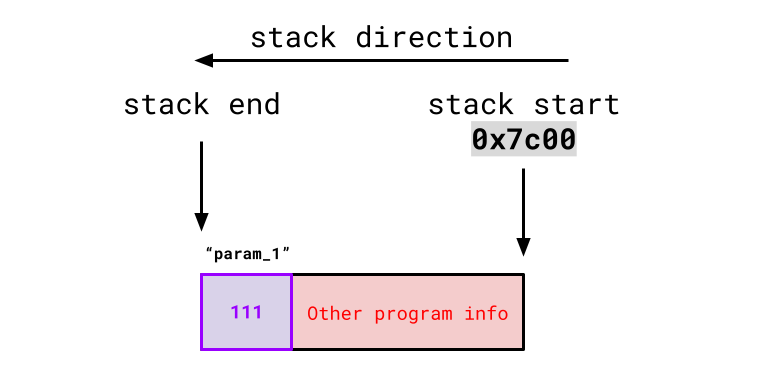
...so any time it uses param_1 in its function body, it will look at the end of the stack for it.
So it's our responsibility from the caller's perspective to push or "append" the first parameter onto the stack so that the callee is in agreement that the first parameter is at the end of the stack.
Thankfully, there's an assembly command that does just this:
push [src]
...where [src] is a register, and its value gets copied and pasted to the end of stack for us (accounting for stack direction).
In C's x86_32 calling convention, it expects parameters to be pushed onto the stack in 32-bit increments. This is a problem in our case since we only want to pass in dl, an 8-bit wide register. However, you can still get around this.
If you want to pass an 8-bit parameter in C's x86_32 calling convention, you place the 8 bits at the lower quadrant of a 32-bit register and push that register on the stack. If the function callee itself knows it's being passed an 8-bit parameter, it will only use the lowest 8-bits of the 32-bit value at the end of the stack (ignoring the upper 24 bits).
Thankfully, dl is already the 8-bit lower quadrant of the 32-bit wide register edx (we discuss register anatomy here), so we can simply push edx onto the stack and only its lower 8-bits (a.k.a. dl) will be used.
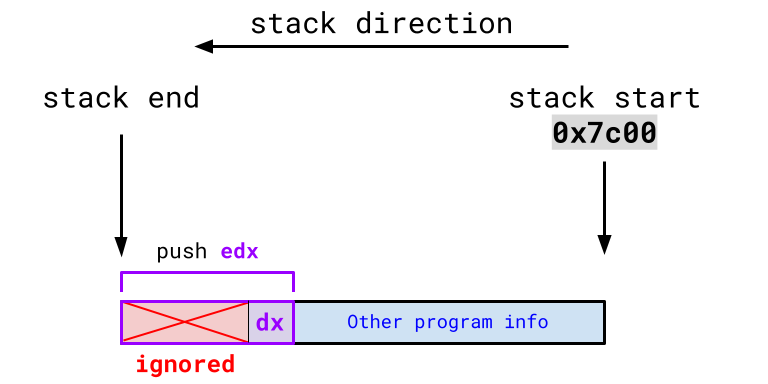
In conclusion, this is just a one-liner assembly command: pushing edx onto the stack before calling stage_1_main.
#[naked]
#[no_mangle]
extern "C" fn entry() -> !
{
unsafe { core::arch::asm!
(
"mov sp, 0x7c00",
"mov ax, 0",
"mov ds, ax",
"mov es, ax",
"mov fs, ax",
"mov gs, ax",
"mov ss, ax",
"push edx",
"call {main}",
main = sym stage_1_main,
options(noreturn)
)}
}
/* Doesn't quite use the correct calling convention just yet */
fn stage_1_main(disk_drive: u8) -> !
{
inf_loop()
}
We've done everything "caller" side. Now let's resolve the "callee" side (which thankfully isn't nearly as difficult).
There's nothing specifying which calling convention stage_1_main should use. Rust functions have no standardized calling convention, but we can override this and specify a calling convention that stage_1_main must adhere to:
We can look at all calling conventions Rust supports through its official ABI string reference: https://doc.rust-lang.org/reference/items/external-blocks.html#abi.
We can see that
extern "cdecl"represents C's x86_32 calling convention.
Updating stage_1_main,
extern "cdecl" fn stage_1_main(disk_drive: u8) -> !
{
inf_loop()
}
The assembly "caller" code and the "callee" stage_1_main function agree to use C's x86_32 calling convention, where the disk_drive parameter is found in the last 8-bits of the 32-bit value at the end of the program stack.
Great! Let's test it: the hard disk's disk drive number on QEMU is always 0x80.
/* ❗ QEMU Only Code!
* ------------------------------------------------------------------------------
* The hard disk's disk drive number may not be 0x80 on other emulators/machines:
*/
extern "cdecl" fn stage_1_main(disk_drive: u8) -> !
{
if disk_drive == 0x80
{
btl_print(b"Success!");
}
inf_loop()
}
Running it on QEMU:

We successfully took in the disk drive number as a parameter in assembly.
Checking for BIOS Interrupt 19 Extensions
Now, we have everything required for BIOS's interrupt 19 extension check. As a reminder, it takes in the following register parameters:
| Register | Expected Value |
|---|---|
ah | The Subservice ID - 65 |
bx | Must be 0x55aa |
dl | The Disk Drive Number |
In Rust:
extern "cdecl" fn stage_1_main(disk_drive: u8) -> !
{
unsafe { core::arch::asm!
(
"int 19",
inout("ah") 65u8 => _,
inout("bx") 0xaa55u16 => _,
inout("dl") disk_drive => _
)}
inf_loop()
}
Furthermore, this interrupt will set the carry flag if extensions are not supported.
❓ What is the carry flag?
The carry flag is one of 32 flags stored in the status register, a special 32-bit wide register where each bit represents a particular boolean flag (0 or 1) that aids in various computer operations.
To extract the value of the carry flag, we can use the sbb (subtract with borrow) assembly command:
sbb [dst], [src]
This effectively does [dst] = [dst] - [src] - carry flag. There's a neat trick we can use if we set [dst] and [src] to the same register, something like:
sbb cx, cx
Then, cx will be 0 if the carry flag isn't set, and -1 if it is set. Rust's inline assembly allows us to extract the value of registers into local variables:
/* Sample Rust code to extract whether or not the carry flag is set
* ----------------------------------------------------------------
*/
let sbb_carry_flag_value: i16;
unsafe { core::arch::asm!
(
"sbb cx, cx"
out("cx") sbb_carry_flag_value
)}
if sbb_carry_flag_value != 0
{
// carry flag is set
}
Before, we've only seen the out command used with just an underscore _ which restores the register's previous state. Supplying a variable will additionally store the register's final value (before the revert) to the variable.
Combining this with the BIOS interrupt call, we have:
let sbb_carry_flag_value: i16;
unsafe { core::arch::asm!
(
"int 19",
"sbb cx, cx",
inout("ah") 65u8 => _,
inout("bx") 0xaa55u16 => _,
inout("dl") disk_drive => _,
out("cx") sbb_carry_flag_value
)}
if sbb_carry_flag_value != 0
{
btl_print(b"BIOS Ext Not Supported!");
inf_loop();
}
I chose to use
cx, but any register works. You can optionally have the compiler select an intermediate register for you:let sbb_carry_flag_value: i16; unsafe { core::arch::asm! ( "int 19", "sbb {sbb_reg:x}, {sbb_reg:x}", sbb_reg = out(reg) sbb_carry_flag_value inout("ah") 65u8 => _, inout("bx") 0xaa55u16 => _, inout("dl") disk_drive => _ )}Previously, we've only seen the
inandoutcommand used with explicit registers.regis one of the many register class in which the compiler gets to choose any register from that class (rather than us supplying an explicit register).You can find information on register classes in The Rust Reference: https://doc.rust-lang.org/reference/inline-assembly.html#register-operands
sbb_regis a template string, just likemainin the nakedentryfunction (you can name these whatever you want). In this case, we tell the compiler to replace thesbb_regtemplate string with a register of its choice from theregregister class.❓ What is the
:xin front of{sbb_reg}?When the compiler gets to choose a register, it will choose a 32-bit wide register by default. Notice how this register outputs to a variable of type
i16or 16-bits wide: this is incompatible!Adding an
:xin front of{sbb_reg}tells the compiler to format its selected register as its 16-bit alias.For example, if it selected the register
ecx(32 bits wide), adding:xwould tell the compiler to format the register as its 16-bit aliascxinstead, which is compatible with the 16-bit wide output variable.
If extensions aren't supported, we can stop the program here with an inf_loop since it's required to make further progress.
Setting Up a Disk Address Packet Structure
Now, we can continue with the main BIOS utility that reads sectors to RAM. This utility is Subservice 66 of Interrupt 19 and takes in the following register parameters:
| Register | Expected Value |
|---|---|
ah | The Subservice ID - 66 |
dl | The Disk Drive Number |
si | Address of Disk Address Packet |
siis a 16-bit wide register generally used to store memory addresses.
Additionally, BIOS will populate the ah register with a return code, where 0 represents a successful load and anything else is an error code.
The disk address packet is a structure that contains all information BIOS needs for this interrupt. It's formatted as follows:
| Size | Description |
|---|---|
u8 | Disk Address Packet Structure Size - 16 in this case |
u8 | Always 0 |
u16 | Number of sectors to transfer |
u32 | Where to place in RAM? |
u64 | Which sector index to start reading from? |
Let's write this in Rust:
#[repr(C, packed)]
struct DiskAddressPacket
{
dap_size: u8,
always_zero: u8,
sectors_to_transfer: u16,
ram_start: u32,
sector_start: u64
}
❓ What is
#[repr(C, packed)]?The
reprattribute changes the memory layout of Ruststructs.By default, the compiler can order
structfields in any way including orders different from the one specified in thestructdeclaration. Additionally, Rust's compiler may add any amount of padding/space betweenstructfields to optimize their memory accesses.However, BIOS expects disk address packets to be layed out exactly in the order specified and with no padding between fields.
#[repr(C)]forces a Ruststructto follow how C handles itsstructs, where fields are placed exactly in the order specified.#[repr(packed)]guarantees no padding/space insertions betweenstructfields.We can combine these 2
reprs with#[repr(C, packed)].
Since the first 2 fields of DiskAddressPacket will always be the same, let's write a constructor that takes in only the last 3 fields as parameters:
impl DiskAddressPacket
{
fn new(sectors_to_transfer: u16, ram_start: u32, sector_start: u64) -> Self
{
return Self
{
dap_size: core::mem::size_of::<Self>() as u8,
always_zero: 0,
sectors_to_transfer: sectors_to_transfer,
ram_start: ram_start,
sector_start: sector_start
};
}
}
DiskAddressPackettakes up 16 bytes of space, so you can just set thedap_sizefield to16, but I like to be more verbose and use Rust'ssize_offunction from its Core Library.
Let's take a look at each of these parameters:
-
sectors_to_transfer: This will depend on how large the rest of our bootloader is. To clarify, this interrupt will only load the 2nd bootloader stage for now.Similar to how stage 1's
.magic_numberlink section prevents it from ever exceeding 512 bytes in size, we can make memory constraints for the 2nd and 3rd bootloader stages. In this blog, my plan is...| Bootloader Stage | RAM Start | RAM End | | :--------------: | :-------: | :-------: | | 2nd Stage |
0x7e00|0x9000| | 3rd Stage |0x9000|0x10000|This will make the stage 2 bootloader 4608 bytes or 9 sectors large.
-
ram_start: We want to load the rest of the bootloader to0x7e00. -
sector_start: Thinking of the hard disk as an array of sectors, index 1 is where the 2nd bootloader stage begins.
Let's construct a DiskAddressPacket on the stack:
const STAGE_2_START: u16 = 0x7e00;
const STAGE_2_END: u16 = 0x9000;
const SECTOR_LENGTH: u16 = 512;
let dap = DiskAddressPacket::new((STAGE_2_END - STAGE_2_START) / SECTOR_LENGTH, STAGE_2_START as u32, 1);
💡 Try defining your numbers as much as possible, raw numbers are unreadable!
Now, we have everything we need to invoke the interrupt:
let load_return_code: u8;
unsafe { core::arch::asm!
(
"int 19",
inout("ah") 66u8 => load_return_code,
inout("dl") disk_drive => _,
inout("si") &dap as *const _ as u16 => _
)}
if load_return_code != 0
{
btl_print(b"Rest of Btl Load Failed");
inf_loop();
}
&dap as *const _ as u16 is how you can get the address of the stack-allocated disk address packet as a u16. Running this code, we see:

Tragic. But, we are allowed to set si manually within the assembly routine. We just need to be extra careful to preserve its state for LLVM, and we can do so through the program stack.
As seen before, the push assembly command adds bytes to the end of the stack, there also exists the inverse pop command which removes bytes from the stack:
pop [dst]
[dst] is a register where the removed bytes will be stored.
Using push and pop in conjunction, we can preserve the state of si:
- Before
siis edited,pushthe old value ofsionto the stack. - Make any necessary edits to
si. popthe old value back into the register.
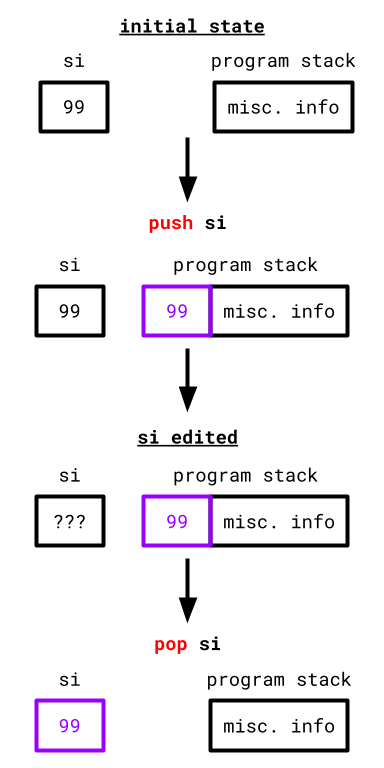
In Rust:
let load_return_code: u8;
unsafe { core::arch::asm!
(
"push si",
"mov si, {addr:x}",
"int 19",
"pop si",
addr = inout(reg) &dap as *const _ as u16 => _,
inout("ah") 66u8 => load_return_code,
inout("dl") disk_drive => _
)}
We preserve the contents of si, and set its value via. an intermediate compiler-selected 16-bit wide register before the interrupt.
Jumping to 0x7e00 in RAM
Hypothetically, the 2nd bootloader stage (which doesn't exist yet) is now loaded at 0x7e00. Let's jump to it using the help of our linker script:
ENTRY(entry)
SECTIONS
{
...
. = 0x7c00 + 510;
.magic_number :
{
SHORT(0xaa55)
}
stage_2_main = .;
}
Recall that the . character is the linker script's location counter. It is set to 0x7c00 + 510. Since the .magic_number link section is 2 bytes wide, the location counter is then updated to 0x7c00 + 510 + 2 = 0x7e00. We then place a new "label" stage_2_main to the location counter at 0x7e00.
Essentially we make a "promise" to Rust's linker, telling it that a function exists at 0x7e00.
We can extract/import this "promised" function Rust-side by using an extern block at the top of the bootloader code:
#![no_std]
#![no_main]
#![feature(naked_functions)]
extern "Rust"
{
fn stage_2_main() -> !;
}
...
This makes the compiler look for a label named stage_2_main in the linker script. Since it's defined at 0x7e00, Rust's compiler will interpret stage_2_main as a Rust non-returning function (from the extern block) at 0x7e00 (from the linker script).
The
externblock by default assumes the use of C's calling convention which is whyextern "Rust"is specified so thatstage_2_mainis treated as a Rust function rather than a C function.
Then, we can simply invoke a call to this "promised" function, replacing the infinite loop:
extern "cdecl" fn stage_1_main(disk_drive: u8) -> !
{
...
unsafe { stage_2_main() }
}
The compiler blindly follows our promise of a function at 0x7e00 regardless of if a function is actually there or not, hence the unsafe block.
Creating the Stage 2 Bootloader
This is where we fulfill our end of the promise.
Let's copy and paste the stage_1 Rust project and rename it to stage_2:
scratch_os
├── bootloader
│ ├── stage_1
│ │ └── ...
│ └── stage_2
│ └── ...
└── kernel
There's only a few changes to be made. Beginning with the Cargo.toml file:
- This doesn't change anything, but I'd change the package name to
stage_2instead of the oldstage_1.
Let's change the linker script:
-
We'll keep the function naming consistent and name stage 2's entry function to
stage_2_main:ENTRY(stage_2_main) -
We want
stage_2_mainto be placed at0x7e00, so we'll initially set the location counter to0x7e00:. = 0x7e00; -
For the actual function placement, we'll place
stage_2_mainto be generated first within the.textsection:.text : { *(.text.stage_2_main) *(.text .text.*) } -
Since the
0xaa55magic number is only relevant to the first sector, we can get rid of the.magic_numberlink section. -
We also want to make sure
stage_2is extended to0x9000. Our BIOS interrupt may fail if we request more sectors to load than what exists on the hard disk. We can do this by simply adding some null bytes at0x9000, similar tostage_1's.magic_numberlink section:. = 0x9000 - 2; .stage_2_end_bytes : { SHORT(0x0000) }
Recall that the SHORT keyword inserts 2 bytes, extending stage_2 to end exactly at 0x9000.
At this point, the stage 2 bootloader's linker script is condensed to:
ENTRY(stage_2_main)
SECTIONS
{
. = 0x7e00;
.text :
{
*(.text.stage_2_main)
*(.text .text.*)
}
. = 0x9000 - 2;
.stage_2_end_bytes :
{
SHORT(0x0000)
}
}
We then define stage_2_main in main.rs:
#![no_std]
#![no_main]
#[no_mangle]
fn stage_2_main() -> !
{
btl_print(b"Hello from stage 2!");
inf_loop()
}
/* ❗ Don't forget your panic handler!
* -----------------------------------
*/
#[panic_handler]
fn panic(_: &core::panic::PanicInfo) -> !
{
loop {}
}
⚠️
btl_printandinf_loopare defined twice instage_1andstage_2!Code duplication should be avoided as much as possible. I create a
commonRust library crate that contains any code used in multiple components of this project (bootloader stages or the kernel).I implement and document this
commonlibrary crate underscratch_os-blog-src/ch01-04-srcwithin this blog's GitHub Repository, I recommend following this approach.
- You can create a new library crate with the terminal command:
cargo new <crate_name> --lib
- You allow binary crates (like the
stage_1andstage_2crates) to use library code by adding the library as a dependency in the binary crate'sCargo.tomlfile.
Now, we need to convert this new stage_2 project into a raw binary. This process is identical to stage_1.
In a shell script:
cd bootloader/stage_2/
cargo build --release
cd target/<name_of_your_json_file>/release/
objcopy -I elf32-i386 -O binary stage_2 stage_2.bin
...or equivalent Rust code if you use Rust for your automatic runner.
Finishing the Disk Image
We now have two raw binary files: stage_1.bin and stage_2.bin.
stage_1.binrepresents the disk image's first sector.stage_2.binrepresents the "rest of the bootloader".
It's time to merge these into one final disk image to run on QEMU. Let's first start by creating an empty file named disk_image.iso.
If your runner code is in Rust:
// Creates an empty `disk_image.iso` file
let mut disk_image_iso = std::fs::OpenOptions::new()
.read(true)
.write(true)
.create(true)
.truncate(true)
.open("<path to your disk image>/disk_image.iso")
.expect("Could not open the disk image!");
❓ What is the
.isoformat?The
.isoformat is typically used for files meant to represent entire secondary storage devices. In our case,disk_image.isorepresents the machine's hard disk.
This is how I envision the disk image to be created:
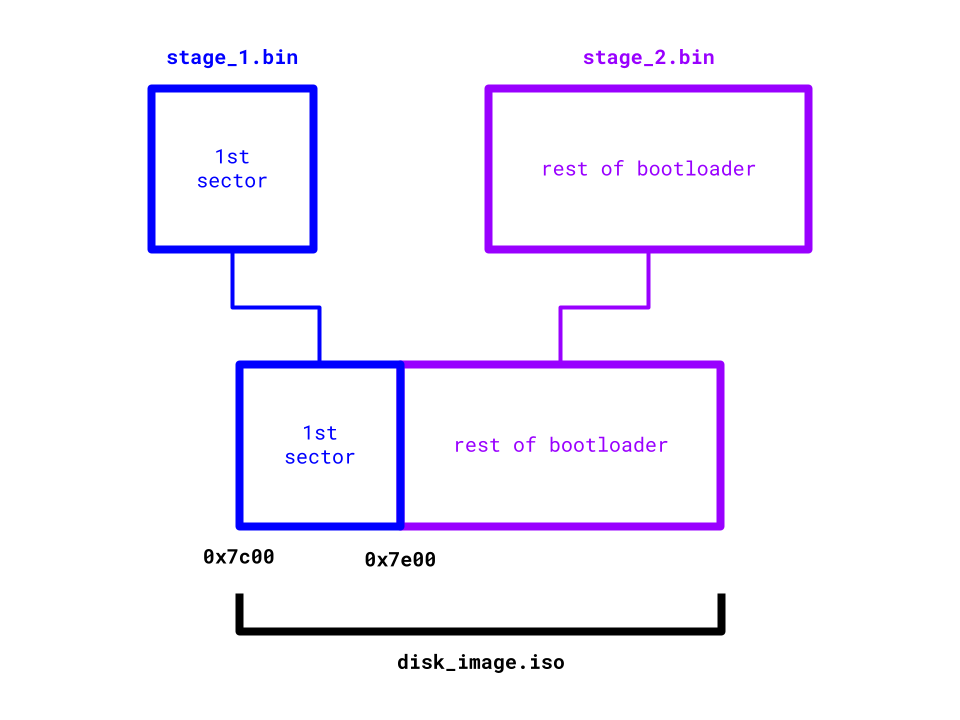
There's a lot of moving parts here:
- At the very start, BIOS will load the first sector (
stage_1), to0x7c00in RAM. At this point, onlystage_1exists in RAM, andstage_2will still be on the disk.
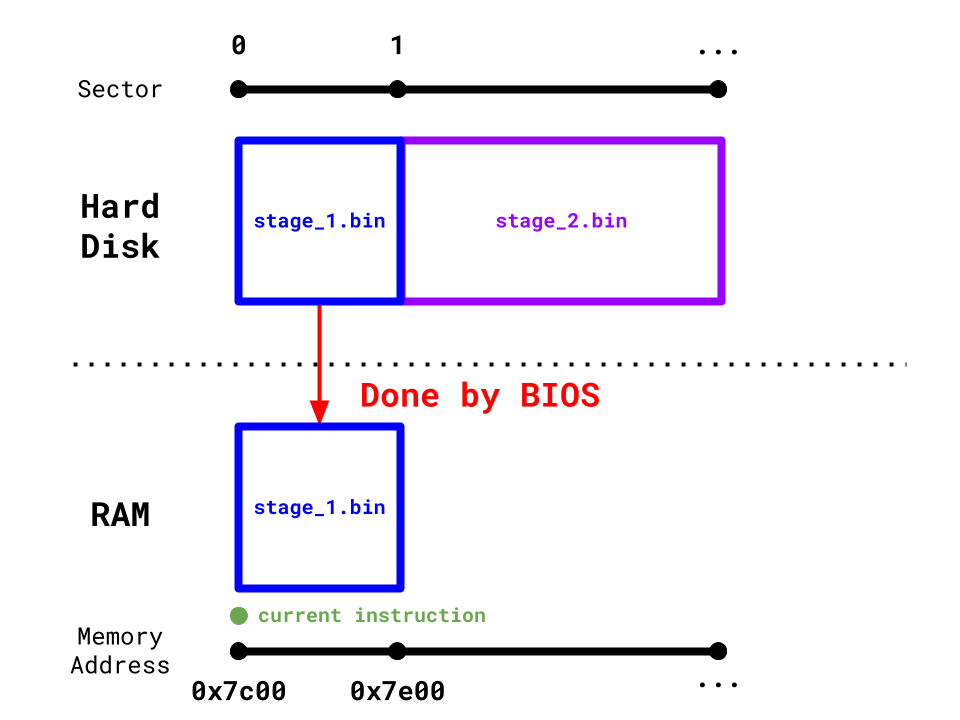
- The code within
stage_1is then responsible for loadingstage_2into RAM at0x7e00.
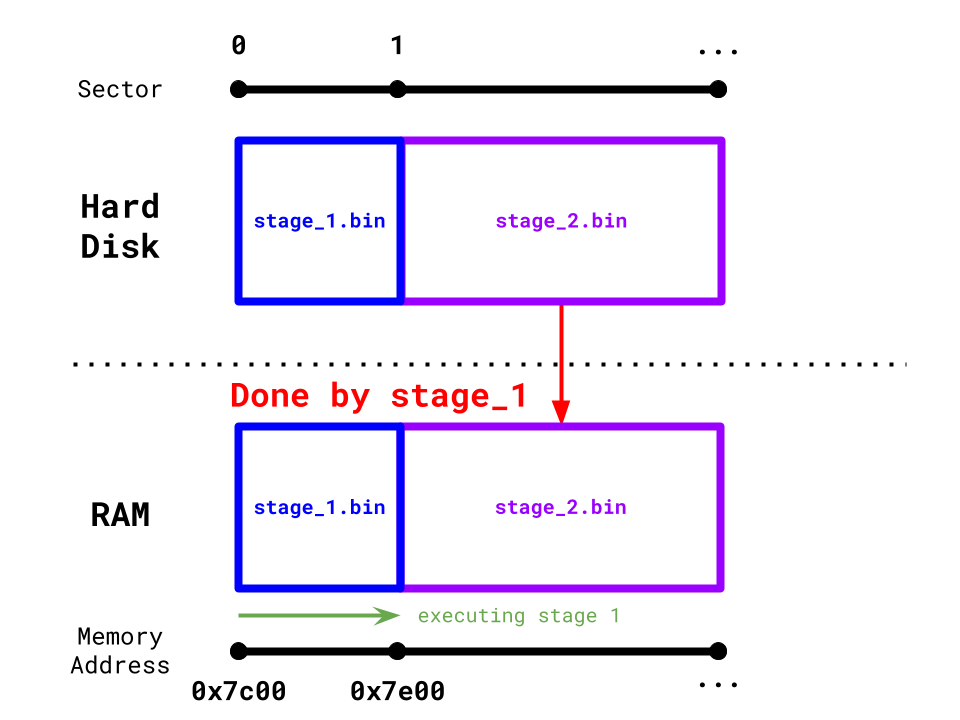
stage_1then jumps to0x7e00, wherestage_2places itsstage_2_mainfunction. Code execution successfully continues instage_2_main(theoretically).
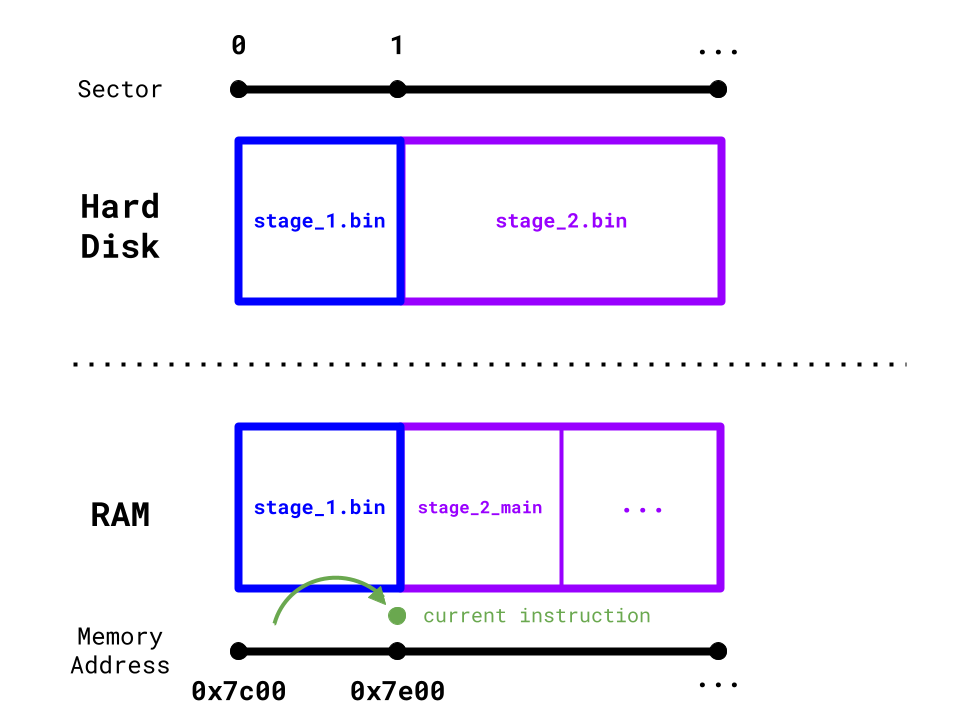
So all we really need to do is add stage_1.bin to the currently empty disk_image.iso, and then directly append stage_2.bin. This will give us the desired disk_image.iso structure. You can use the dd command to accomplish this if you use a Makefile or shell script.
In Rust:
// create a handle to `stage_1.bin`
let mut stage_1_bin = std::fs::File::open("<path to your stage_1.bin>/stage_1.bin")?;
// create a handle to `stage_2.bin`
let mut stage_2_bin = std::fs::File::open("<path to your stage_2.bin>/stage_2.bin")?;
// append `stage_1.bin` to `disk_image.iso`
std::io::copy(&mut stage_1_bin, &mut disk_image_iso)?;
// append `stage_2.bin` to `disk_image.iso`
std::io::copy(&mut stage_2_bin, &mut disk_image_iso)?;
Let's run our newly created disk_image.iso on QEMU:
qemu-system-x86_64 -drive format=raw,file=<path to your disk image>/disk_image.iso
You will see one of two results:
- If you didn't create a
commonlibrary crate to store shared functions (not my recommendation), you should have successfully seenHello from stage 2!

- However, there can be complications if you did create one (which is my recommendation since you get to not wastefully duplicate your code) and see this:

🆘 What do I do if I created a
commonlibrary crate? Is it over?No, but the issue is pretty hard to spot: the process of linking the library crate with our bootloader projects necessitated the linker to generate new link sections that we haven't mapped yet.
We talk about link sections here in case you want a refresher.
In our case,
stage_1additionally generates the.rodatalink section. If a link section is left unmapped, the linker is free to place it wherever. In this case, the.rodatasection gets placed before.text, and we can verify this by reusing thereadelftool:

Notice how it lists
.rodatagenerated subsections before the.textsection. Also notice how the entry point is now at0x7c30and not0x7c00, being displaced by.rodata. This means when the CPU starts execution at0x7c00, it reinterprets memory in.rodataas computer instructions: all bets are off on what the machine does at this point.We can mitigate this by mapping the generated
.rodatasections/subsections to be after.textin the linker script:SECTIONS { . = 0x7c00; .text : { *(.text.entry) *(.text .text.*) } .rodata : { *(.rodata .rodata.*) } ... }Let's rerun
readelfto confirm that.textis correctly placed at the start of the binary:
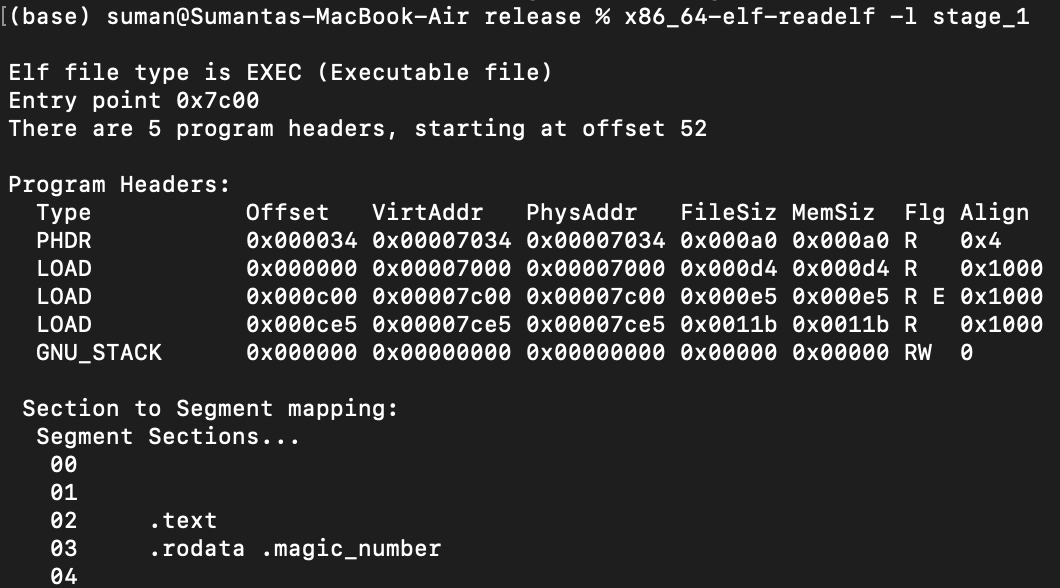
Perfect!
Unfortunately, new
.rodatalink subsection generation also happened withstage_2(since it also uses the library crate), so repeat the mapping process withstage_2to ensure that the new.rodatais placed after.text.Now with all link sections correctly ordered, let's rerun our program:

We ballin.
Our stage 1 bootloader is complete 😊! In other words, we have escaped the constricting 512-byte memory restriction and can now do so much more.
We'll begin writing our stage 2 bootloader in the next chapter.
TODO: have to set ds to 0 during dap creation
TODO: talk about string length and executable size
TODO: link section fix not just based on library crate. talk about potential .got and other sections (check for 512 even if shows after .magic_number)
TODO: Split into 2 sections